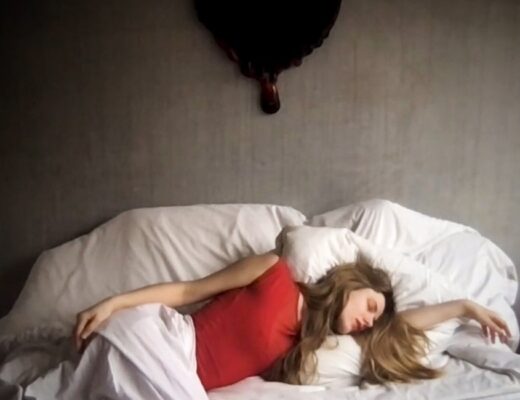Advanced mathematics on film is often treated as a gateway to mental illness (Pi) or espionage (The Imitation Game) or in some instances both (A Beautiful Mind); rarely is it foregrounded to the extent that it is in Anna Novion’s Marguerite’s Theorem, the reasons for which are obvious in hindsight. There is questionable cinematic value in watching someone excitedly scribble long, inscrutable formulae on a chalkboard, there’s little incentive for genuinely brilliant characters to stop and explain what they’re doing for the benefit of the audience, and, even if they did, it all runs the risk of turning into, well, school. Inferring successes and setbacks, then, relies almost entirely upon contextual clues, such as elevated breathing and a quickening of pace as a proof is written out, or murmuring from the peanut gallery followed by a furrowed brow of the person standing in front of the class to signal something is amiss. One can be watching someone triumphantly prove a theorem that’s eluded mathematicians for centuries, or having years worth of work invalidated, in the blink of an eye — and in both instances, the viewer must patiently wait to be told which is which.
The Marguerite of this film’s title is a 25-year-old PhD candidate at the École Normale Supérieure in Paris played by Swiss actress Ella Rumpf (Raw). The only woman in her discipline at ENS — the film opens with the character being interviewed for a newsletter which allows us to quickly get up to speed on someone who concertedly refuses to reveal more of herself — Marguerite is in the final year of her studies, having dedicated years to making incremental progress in solving Goldbach’s conjecture, a theorem from the 1700’s that still remains unproven. We learn that math is her entire life (when pressed on her hobbies, the best she can muster is taking walks to clear her head and playing Yahtzee with her mother) and that she is weeks away from presenting her thesis, the culmination of her studies, paving the way to publication and advancement in her field. But while presenting her work for peer review, a previously undetected yet catastrophic error is discovered in Marguerite’s work, invalidating her theorem and forcing her to consider abandoning it entirely and devising an entirely new thesis in a matter of months. Like much of the film, this moment of complete and total professional devastation plays against quiet disbelief from learned observers and Rumpf’s steely outer resolve.
But on the inside, Marguerite is spiraling out. She questions her talents and even her life’s pursuit, all exacerbated by her longtime faculty advisor, Professor Werner (Jean-Pierre Darroussin), who drops her to focus on Lucas (Julien Frison), a hotshot transfer from Oxford. Confronted by failure and an uncertain future, Marguerite impulsively drops out of ENS and contemplates a life outside of math only to find that a head full of numbers can be both a blessing and a curse. She’s quickly bounced from a data collection job after demonstrating a greater understanding of surveys than her impatient supervisor. However, she also displays a real aptitude for mahjong, besting seasoned gamblers in illicit backroom games seemingly seconds after sitting down at the table, ensuring she’ll always have rent money. It’s while playing mahjong that an epiphany has her reconsidering her flawed theorem. With the spark of inspiration returning to her, she rededicates herself to proving not only her own thesis, but potentially unlocking Goldbach’s conjecture itself.
Novion rests much of her film’s success on the shoulders of Rumpf, playing a character who’s told, point blank, that she’s “too cold and too closed.” Marguerite has a nasty tendency of alienating Lucas before he can get too close to her — the side effect of a fraught relationship with her absentee father — which leads to her repeatedly crawling back to him, brusquely imploring him to resume their work together in what increasingly becomes a flimsy pretext to obscure her feelings. This is a prickly yet bloodless character study of a solitary woman prone to irritability, rudeness, and obsession: the further she goes into her work, the more it takes over the her small, shared apartment, her scrawlings covering every surface, post-it note, pane of glass, and even working their way around a roll of toilet paper. It’s not so much a question of whether Marguerite can have it all as it is will she allow herself to accept happiness — a somewhat banal character arc, but one mitigated by a welcomingly prickly performance by the film’s lead actress.
For all the attention paid to theorems and formulae, Marguerite’s Theorem does little to obscure how conventional and almost trite the film can be. Marguerite’s adventures at the mahjong table play like something out of Rain Man or The Hangover, complete with complex equations superimposed over Rumpf’s face as she takes down game after game. There’s also no getting around the fact that Rumpf is one of the most glamorous young actresses in the world (she even briefly appeared on Succession as a Contessa) and that costuming her in glasses and frumpy sweaters does not begin to explain her almost nonexistent social life. Theoretically, the film resembles a sports movie in which Marguerite must — metaphorically — pick herself up off the mat, build her confidence back up, and step back into the ring; in its approach, however, it always keeps the viewer at arm’s length. Marguerite frequently finds inspiration in the everyday, her face lighting up as something dawns on her, causing her to rush off and resume her work. Yet throughout, we are little more than her dispassionate observers, at a loss over what it all means, taking our cues from imperceptible changes in her face as to whether a development is positive or negative. It all feels a bit like auditing a graduate course where you spend the entire time praying that nobody calls on you.
Published as part of InRO Weekly — Volume 1, Issue 21.







